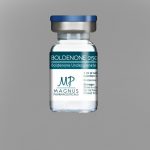Znalazłam ciekawy artykuł na temat masy mięśniowej. Jest on w języku angielskim, ale postaram się go przetłumaczyć w najbliższym czasie. Wklejam go już teraz, aby każdy kto choć trochę zna ten język mógł parę rzeczy sobie usystematyzować. Artykuł nie jest może odkrywczy, bo informacje w nim zawarte są poruszane na forum, natomiast bardzo obrazowo tłumaczy np dlaczego mamy utrzymywać odpowiednie tentno podczas ćwiczeń, czy jaka ma być ich intensywność.
Muscle Mass Myths
by Ron Brown
author of The Body Fat Guide
THERE ARE many fine books, magazines, instructional videos and trainers who can provide information on how to perform exercises that build muscle. Whether using free weights, machines, cables or free-hand exercises, mastering the principles of resistance training is fundamental to building muscle. However, what is often lacking in these how-to guides is information on how to best organize one’s diet, rest schedule and exercise routine to maximize results.
The following advice is designed to be incorporated into your training program. It will help you overcome muscle mass myths, and improve your muscle-building progress, drug-free! It is not a guide on how to correctly perform the exercises. For that, consult any of the resources mentioned above.
Contents:
Exercise Intensity
Blood Flow
Range of Motion
Calorie Intake
Recuperation
Definition
EXERCISE INTENSITY
What is it about exercise that makes a muscle grow? Intensity! Weak effort produces little growth. Maximum effort produces maximum growth, all other factors being equal. So that means you should always lift the heaviest weight in strict controlled form, right?
WRONG! The idea that you need to lift heavy weights to maximize intensity may be a great way to sell you lots of weights and machines to store in your basement (my basement certainly was filled with this merchandise at one time). But the truth is, lifting heavy is not always the best way to increase intensity!
Don’t get me wrong, lifting heavy weights is intense, and for strength building, lifting heavy is essential. There’s no doubt that muscle growth will occur while training heavy, but training exclusively with heavy weights may actually slow down your progress.
A better way to measure intensity, other than by simply lifting heavier weights, is to calculate how much work you are performing within a certain period. Work is determined by how much you lift and how many times you lift it, regardless of the amount of time it takes. On the other hand, the power or intensity of your work is measured over units of time.
To illustrate, let’s say you curl 100 pounds 10 times. You do this for 3 sets, all within five minutes. In five minutes,
you will have curled 100 pounds 30 times, lifting 3,000 pounds! The power or intensity of your work is 600 pounds per minute.
Now let’s say I curl half the amount of weight you used, 50 pounds, but I curl it 25 times. I also do 3 sets of this within five minutes. In five minutes, I will have curled 50 pounds 75 times, lifting 3,750 pounds! The power or intensity of my work is 750 pounds per minute versus your piddlely little 600 pounds per minute, big guy! Now, you tell me who is working more intensely!
BLOOD FLOW
Regardless how intensely you think you are working, there is one sign that will never fail to tell you if you are working intensely enough: increased blood flow into the muscle, physiologically called hyperemia, a.k.a. „THE PUMP”! The pump is not just a „side effect” of exercise. For muscle-building purposes, the pump is the main goal of exercise.
No one can say for sure why pumping up an undeveloped muscle will make it grow, but experience shows that it does…every time, always, no exceptions! (all other factors like proper food and rest being equal, of course). By the way, testosterone is not necessary for this type of muscle growth to occur.
Testosterone is a hormone that creates new muscle fibers in boys as they develop into adults. These new fibers are made out of permanent structural proteins. Testosterone has little effect in creating new fibers in adults. The type of growth we are talking about here is the increase in the size of existing fibers in both men and women, not the creation of new muscle fibers. This enlargement of existing fibers is due to the addition of labile or temporary proteins (mainly actomyosin). The pump is the best way to deliver these proteins and other nutrients to the muscle fibers.
Achieving a pump requires strict attention to timing. Filling up your muscles with extra blood is like filling water into a bucket with a hole in the bottom. Fluid has to flow into the vessel
at a faster rate than flows out of it. That means you can’t take a break and start socializing while in the middle of working toward a pump. Work with maximum intensity (see the previous heading) until you achieve a pump. Then, when you can’t get it pumped any more, QUIT EXERCISING that muscle. Nothing deflates a pump quicker than over-exercising.
RANGE OF MOTION
You should always perform each exercise through the muscle’s full range of motion to get maximum muscle-building effects, right? WRONG again!
Now, that doesn’t mean exercising a muscle through its full range of motion isn’t important…of course it’s important. But you don’t have to cover the full range of motion in
every exercise. Reps with partial-range-of-motion movements are very effective for increasing intensity where the muscle’s range of motion is naturally strongest. If you always exercised with full-range-of-motion movements, the total intensity of the exercise would be determined by the weakest part of the muscle, and so the exercise would end before the strongest part received maximum benefit.
For example, due to the leverage produced by its insertion at the tendon, the lower part of the biceps near the elbow is weaker than the point midway in the muscle belly. If you always did strict barbell curls with full range of motion, your set would end when the lower part of the muscle, the weakest part, couldn’t move the weight anymore. The result is that there is still plenty of potential strength left in the stronger middle part of the muscle, but it is not fully developed.
CALORIE INTAKE
Protein is important for building muscle. But you could eat 100% of your calories from protein, and you won’t gain an ounce of muscle if your daily total calorie intake isn’t greater than your daily calorie output.
To build muscle, you require a balanced diet that provides approximately 300-500 more calories than your maintenance calorie intake level. (You can determine the actual amount of extra calories you require to gain muscle without gaining fat by checking changes in your body composition measurements.) All the protein you require to build extra muscle will be contained in this amount of food, provided your diet is balanced properly.
A diet that provides 10%-15% of calories from protein IS ALL THAT IS REQUIRED TO GROW MUSCLE.
Don’t believe it? Consider this: Infancy is the time of a human’s life when growth is the most rapid, and when protein needs are the highest. Yet, human breast milk contains only 10% protein by calories (versus about 30% for cow’s milk). This is more than adequate to meet the needs of a growing human infant who doubles its weight in 6 months and triples its weight in a year.
You aren’t going to grow new lean tissue nearly as fast, (0.5-2.5 pounds a week) so forget about stuffing yourself with protein…just eat a balanced diet. Besides, when your protein intake is too high, you crowd out other calorie-dense foods from your diet that are needed to provide energy, and that spare protein for growth. Why do you think people lose weight on a high-protein diet?
The subject of how to measure and adjust your energy balance is covered in greater detail at bodyfatguide.com, so check it out. Just remember: Exercising to build muscle without feeding yourself a proper amount of a balanced diet is like painting a picture with no paint on the brush. You’re just going through the motions, and there’s nothing left to show for your effort.
RECUPERATION
If you check your body composition after an intense workout, you’ll notice your lean body mass level is down. That’s because anaerobic muscle-building exercise actually burns muscle components for fuel (mainly glycogen, water and minerals).
To gain muscle, just stuffing in extra calories won’t get you anywhere if you don’t give your body time to synthesize new tissue out of those calories. The body ordinarily discards old tissue and synthesizes new tissue every day. For there to be a net increase in muscle mass, total growth has to proceed at a faster rate than the break down of muscle through exercise and other activity.
Eating and resting just enough to replenish your muscle mass back to where you were at your last workout isn’t enough. If you are serious about packing on muscle, DON’T REPEAT YOUR WORKOUT ROUTINE UNTIL YOU ARE AT LEAST 1/4-1/2 POUND HEAVIER! That could take as little as 1 rest day or as much as 3 or 4 days. Let your results be your guide. Check your body composition at the percentage body fat page to make sure you are within a healthy range.
Here’s a suggested mass-gaining routine you can use as a basic guide. Adjust it according to your results. Work your whole body in no more than one hour while performing 20 reps per set. Eat 300-500 calories above your maintenance calorie level on your workout day. (Don’t forget to include the calories your workout burns as part of your maintenance calorie level.) To calculate your daily maintenance calorie level, see the link to bodyfatguide.com below. Then take the next 2-3 days off and continuing eating 300-500 extra calories above your daily maintenance level.
Repeat the routine, this time performing 8-12 reps. Continue to cycle between 20 reps and 8-12 reps from workout to workout. You may also try going as high as 50-100 reps and as low as 3-6 reps. Cycle between a wide variety of repetition ranges. You may be surprised by your gains!
Some people find that growth occurs best when they give their whole system a complete rest on their days off. However, a popular schedule is to train your entire body over the course of 3 days, training different body parts each day, and then taking one day off. This „3-On, 1-Off” routine gives each muscle group 96 hours for rest and growth. It’s great for bringing out the shape and hardness of your muscles.
However, if you find this routine is too much work to allow maximum growth, try dividing your entire full-body routine into 2 shorter workouts, performed twice a week. So, train one-half of your body on one day, the other half the next day, then take a day off. Repeat two more days of training and follow this with 2 days-off to complete one week.
DEFINITION
Some authorities suggest that one pound is the maximum amount of muscle a person can gain in one week without gaining fat. Other authorities suggest 2 pounds a week as a maximum. Greater muscle gains are possible, but this will usually not be totally fat-free.
People who have burned off large amounts of muscle mass while crash dieting, fasting and over-training are often surprised how quickly their muscle mass returns when they get more rest and increase their calorie intake. Sometimes referred to as „muscle memory,” this rate of rapid muscle mass replenishment should not be confused with new muscle growth. It takes much longer to gain new levels of muscle mass than it does to regain mass you recently burned off.
Is it worth gaining a few ounces of body fat if you are successfully gaining pounds of muscle? That is a question you will have to answer for yourself. The point is to minimize fat gain while gaining muscle. You can actually maintain the same body fat percentage as you gain muscle if your body fat gains are small enough. Do this by fine tuning your energy balance according to your body composition results.
You may also wish to gain a few pounds of mass, trim it up without losing muscle, then repeat the cycle. The important thing is that the end result leaves you with more muscle and with less body fat. If you gain as much body fat as muscle, and then lose as much muscle as body fat, you will end up right back where you started!
For more information on how to adjust your diet and exercise to lose body fat without losing muscle, see Are You Getting Workout Results? Whether trying to gain muscle or lose body fat, DON’T TRY TO ADJUST YOUR DIET & ACTIVITY BY FEEL! Follow the numbers to get it right. All the information you need is at
bodyfatguide.com. Let your results be your guide as you refine your diet and activity adjustments. Soon it will all become a habit!
Be sure not to miss I Walked My Way to 4.3 % Body Fat.
R.B.
(oryginalny link: [http://www.bodyfatguide.com/MuscleMassMyths.html] )
Ok tłumaczenie, przy czym skupię się na wnioskach.
Masa mięśniowa jak wiadomo jest niezbędna, także aby dokonać dobrej redukcji. Im większa masa mięśni, tym więcej kalorii spalamy tak ot. Czyli rośnie nasz metabolizm spoczynkowy.
Dla uzyskania dobrej masy mięśniowej (tzn tak aby skład ciała był proporcjonalny, chodzi o zawartość w ciele suchej masy mięśniowej i tłuszczu) niezbędna jest wiedza na temat:
INTENSYWNOŚCI ĆWICZEŃ
PRZEPŁYWU KRWI
SKALI RUCHU
PRZYJMOWANYCH KALORII
REKONWALESCENCJA
DEFINICJA
INTENSYWNOŚĆ ĆWICZEŃ
Przede wszystkim intensywność ćwiczeń nie wiąże się wyłącznie z dźwiganiem ciężarów o największej masie. Ważniejsze jest skalkulowanie ile pracy włożyłeś w danej jednostce czasu. Jeśli podnosisz 50kg 10 razy w 3 seriach, a robisz to w ciągu 5 minut, to podnosisz 1500kg w ciągu 5 minut. Czyli 300kg/minutę.
Jeśli zmniejszysz wagę o połowę do 25kg, i zdołasz zrobić 25 powtórzeń, to podnosisz w ciągu 5 minut 1875kg, co daje 375kg na minutę. Czyli całe 75kg więcej!
PRZEPŁYW KRWI
O tętnie pisano w wielu postach wiele. Łatwo można odszukać tematy pomagające ustalić tętno maksymalne i to przy którym należy ćwiczyć. Ale dlaczego najlepsze efekty nie są gdy mamy zbyt duże tętno? Tętno warunkuje ilość krwi która przepływa przez nasze mięśnie. Krew ta niesie składniki odżywcze, białka i testosteron. Wszystko to ma wpływ na budowę mięśni. Idealne tętno można porównać do lania wody przez lejek do wiadra. Jeśli będziemy lać za mocno to woda po prostu zamiast do wiadra trafi poza.
SKALA RUCHU
Z tą skalą ruchu jest tak jak z powiedzeniem o łańcuch. O jego wytrzymałości decyduje najsłabsze ogniwo. Z mięśniami jest podobnie. Jeśli ćwiczymy w pełnym zakresie dany mięsień, męczy się on zanim włókna najsilniejsze zdążą się napracować. Intensywność determinowana jest przez najsłabsze włókna. Jeśli ćwiczymy w niepełnym zakresie rozwijamy naturalną siłę mięśni. Warto więc ćwiczyć i tak i tak 
PRZYJMOWANIE KALORII
Autor artykułu twierdzi, powołując się na rozwój niemowlaków, że do wzrostu mięśni nie są wyłącznie potrzebne proteiny, czyli białko. W mleku matki kalorie pochodzące z białka to zaledwie 10% wszystkich. Knif polega na tym, że jedząc zbilansowane posiłki, oszczędzamy białko do budowy mięśni, wykorzystując pozostałe składniki aby mieć energię np. do ćwiczeń.
Więc wysokobiałkowa dieta wcale nie ułatwi nam rozwoju mięśni. Ale zrobi to dieta zbilansowana.
REKONWALESCENCJA
Po zbyt dużym wysiłku masa mięśniowa maleje, ponieważ mięśnie nieareobowe palą podstawowe składniki mięśnia, a więc glikogen, wodę i minerały. Nie rozwiniesz mięśni jeśli nie pozwolisz ciału zbudować z dostarczanych kalorii nowych tkanek. Regeneracja nastąpiła gdy jesteśmy o ok 100-250g ciężsi (chodzi o masę mięśniową). Zajmuje to od 1 dnia do nawet 3-4.
Zalecenia autora: jedz 300-500kcal więcej niż jest twoje zapotrzebowanie w dniu treningu. Do zapotrzebowania włącz koniecznie także ilość kalorii które podczas treningu spalisz. W czasie przerwy również jedz 300-500kcal więcej. Dobre efekty przynosi też zmiana liczby powtórzeń w ćwiczeniach!
Jeśli trening całego ciała jest zbyt dużym obciążeniem, ćwicz jednego dnia połowę, drugiego następną, a potem dzień przerwy.
DEFINICJA
Autorytety twierdzą że półkilogramowy przyrost masy mięśniowej w tygodniu jest najlepszy aby nie przybywało także tłuszczu.
Osoby po wyniszczających dietach, czy treningach często są zdziwione jak szybko przyrasta im masa mięśniowa jak tylko wprowadzą odpoczynki i zaczną jeść więcej kalorii. Jest to jednak odnowa mięśni, a tworzenie nowych zajmuje znacznie więcej czasu.
Czy warto wraz z mięśniami pozyskać tłuszcz? To zależy. Jeśli % udział tłuszczu w naszym ciele jest niewielki, wraz z rozwojem mięśni można utrzymać skład procentowy ciała. Jeśli mamy tłusczu zbyt dużo, dobrze jest robić okresy redukcji i masy na zmianę. Celem jest osiągnięcie odpowiednich proporcji mięśni i tłuszczu w ciele.
Ufffff….. to z grubsza tyle….
Zapraszam do dyskusji na forum klikając TUTAJ
Tłumaczenie: korni78 (sfd)








